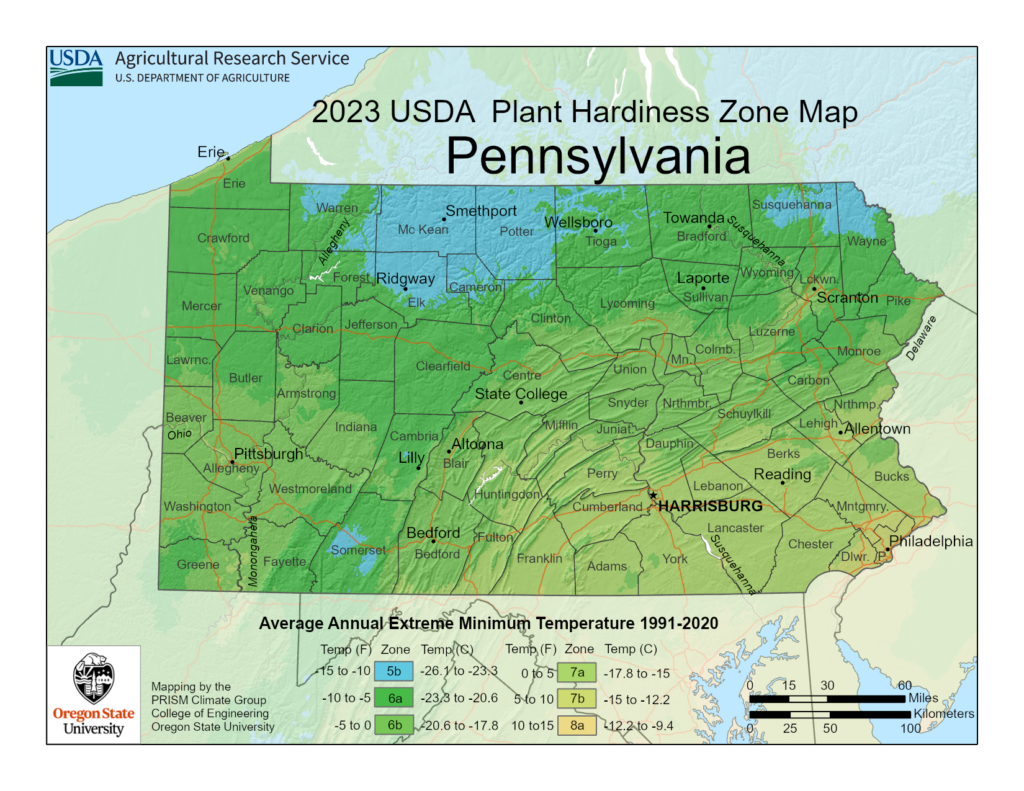Pennsylvania is marked by cold winters and moderate summers. This area of the country may seem like an unlikely place for tropical palm trees but with the selection of the right species and proper winter care, growing palms in Pennsylvania is feasible in warmer sections of the state.
The slim portion of Pennsylvania that is marked as USDA zone 7b can handle a few varieties of cold hardy palm trees, while the rest of the state can only be populated by the extremely cold hardy needle palm.
Any palms planted in the ground in Pennsylvania risk dying during particularly hard freezes.
Pennsylvania USDA Hardiness Zones

USDA Hardiness Zone Range: 5a-7b
Ideal Locations for Palm Growth in Pennsylvania:
- Philadelphia – USDA zones 6b-7b
- Any locations that fall in 7b
Use the hardiness map to determine the best palm varieties for your specific area in Pennsylvania. The state’s climate can accommodate a couple cold-hardy palms.
Cold Hardy Palms Suitable for Pennsylvania
While tropical species like coconut and queen palms are unsuitable for Pennsylvania’s climate, several cold-hardy palms can thrive:
Chinese Windmill Palms: Exceptionally cold-tolerant, these palms can endure temperatures as low as 5 degrees F for short periods when mature. Young plants require protection during extreme cold.
Pindo Palms: Also known as jelly palms, they can withstand brief temperatures in the mid-10s F with proper winter care. They are susceptible to trunk damage at temperatures below 15 degrees F.
Needle Palms: Known as the hardiest palm species, needle palms are slow-growing but can adapt well to cold temperatures if properly insulated during winter. Can handle down to -15 degrees F.
Saw Palmetto Palm: This species can withstand temperatures down to 0 degrees F.
These palms may struggle during particularly harsh Pennsylvania winters.
Winter Protection Strategies
Selecting the right location is crucial for the survival of palms in Pennsylvania:
- Plant in south-facing spots near building foundations or walls for added warmth and protection from cold winds.
- Choose areas near natural heat retainers like boulders or rocky landscapes that store heat from the sun.
To insulate your palms before the deep winter sets in:
- Consider using frost cloth as a protective measure.
- Wrap trunks with burlap.
- Cover the entire plant with breathable frost cloth.
Growing Palms Indoors
In colder parts of Pennsylvania or for more exotic palm varieties, growing palms in pots is a better option. These palms can be kept outdoors or on patios during summer and moved indoors during cold winters.
Here are the best indoor palm varieties to consider planting:
- Kentia Palm Tree
- Areca Palm
- Lady Palm
- Chinese Fan Palm
- Majesty Palm
- Sago Palm
Conclusion
While it requires careful planning and maintenance, growing palms in Pennsylvania’s climate is possible in the warmest parts of the state.
